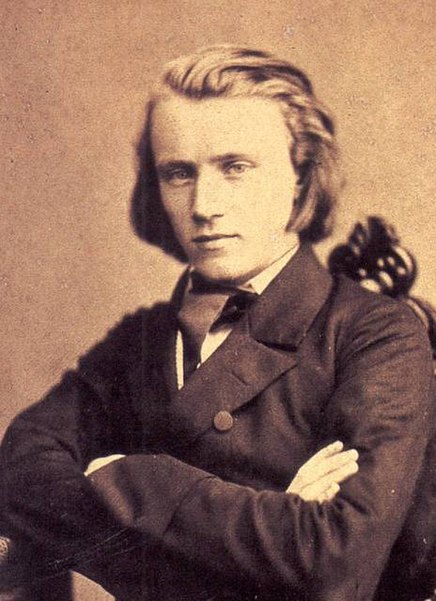Johannes Brahms (born 1833) is a strange case in the world of classical music; unlike most classical composers of his time, he did not start composing until well into middle-age (as far as I know; I'm at the age when my mind begins to invent 'facts' that I can then disseminate to unsuspecting innocents). According to most accounts he had a hard childhood, since his mother worked as a seamstress (or something similarly menial) in what amounts to a whorehouse, where he learned to make a little extra money playing the piano, and gradually moved on to being a bar pianist. The photo at right [Wikipedia] shows him in 1853. As far as we know, Brahms never married.
Somehow he came to the attention of Robert Schumann, who was a powerful personality, and who had an impact on all musicians with whom he came into contact. The Robert and Clara Schumann team were the center of a music-literature-poetry-theater group of friends, who gathered together regularly to discuss their common interests, and Brahms is known to have been a frequent visitor in the Schumann home.
Clara, Robert's wife, was a learned woman and a gifted pianist. Legend has it that in the course of time, Brahms formed an attachment to her, at a time when Robert was in a mental hospital, and beleaguered Clara was managing all their household affairs by herself. Robert Schumann was manic-depressive, and died while under treatment at a mental asylum, at which point Brahms is believed to have taken major responsibility for Clara and her children. Clara Schumann was roughly 14 years Brahms's senior.
Brahms's music is extraordinarily rich and harmonious, almost invariably pleasing to the ear. This is often seen as a negative, though it should be a positive. I'm personally acquainted only with a small portion of his works, and you're welcome to the little I know. Don't get me wrong; Brahms is probably one of my three most favorite composers.
As remarked in an earlier post, Brahms's first attempt at symphonic orchestration was the beautiful
Variations on the St Anthony Chorale. In the lovely opening movement, you hear the chorale theme played in the woodwinds, with the clearly audible lower strings (cellos and basses) playing pizzicato:
plucked. The second movement is dark and ominous; we really have to believe that composers of these times actually enjoyed writing these kinds of foreboding movements. Luckily, it is a short movement. The third movement is even more scary; is it Brahms trying to be Beethoven? You must realize the Beethoven was everyone's hero at the time Brahms was composing. Later movements are lovely and lyrical, including a lovely one in triple time.

Brahms wrote a gorgeous violin concerto
for the brilliant violinist Joseph Joachim. As I probably said earlier, this is (along with Beethoven's violin concerto, often described as "monumental") a symphonic concerto, that is, a concerto whose significance has more to do with the power of the musical ideas it contains and how they are developed, rather than for the virtuosity of the violin part. The opening is a unison sentence played softly by the strings and woodwind, except for the last two chords. The rest of the movement unfolds with great urgency and seriousness. By this time he was, to my mind, already a brilliant composer and orchestrator, though musicologists and theorists have always found his orchestration "wrong". But the final judge is the ear, and one feels that Brahms got precisely the sound he desired. Close upon the end of the first movement, there is a
cadenza in the traditional place. The orchestra pauses at a so-called "cadential 6-4", i.e. a chord in the tonic with the fifth in the bass, and the solo violin is given to improvise a brief rhapsody, ending with a trill, at which point the orchestra enters to complete the cadence. The most well-known and tasteful of these cadenzas over the years have been notated and saved, and the justly most popular is by Fritz Kreisler. Jascha Heifetz wrote his own cadenza, a brilliant passage, containing most of the best ideas of the Kreisler, but adding many virtuoso features. Here is
Henryk Szeryng playing the first movement. (Remarkable clip; YouTube seldom allows more than 10 minutes for a video.) Here is
Sarah Chang playing the same movement; she enters at around 2:40.
The second movement, in quadruple time is a gentle melody first introduced by the oboe, with a few quite agitated passages (which make it a little unsuitable for helping one to sleep). The third movement is a jolly melody of gypsy (or Hungarian) inspiration, brilliant and rollicking, featuring double- and triple-stopping.
Very late in his life, Brahms composed a lovely
double concerto, for violin and cello. (Be patient with this recording: the lower notes of the cello need to be muted a bit. There is a lot of solo mumbo-jumbo until about 2:12.) I think this one is probably one of the most romantic concertos written (together with Mozart's
Sinfonia Concertante, which is a double concerto for violin and viola). Set in A minor, this work presents a conversation between the violin, the cello, and the orchestra; since this is music of the post Beethoven era, we may consider ourselves at liberty to imagine such fanciful things. The music never gets too unbearably saccharine, nor too rambunctiously jolly; it always stays within that band of behaviour appropriate for mixed company, as the saying goes. Still, the concerto is unforgettably lovely, and has strong opinions to express. [On a side note: one of the themes has been discovered to spell out AGADHE. This is not so remarkable, except that late in life Brahms is known to have been engaged to a young woman named Agathe, but to have subsequently broken off the engagement.]
Brahms was a capable pianist, and was recognized as one in his lifetime. (There are even a few --quite terrible-- recordings of his playing on wax cylinders, etc.) His earliest compositions were for piano. In 1859 he wrote his first concerto, for piano in D minor ---he would have been around the age of 26. Much later, he wrote his second piano concerto, in 1881, in B Flat major.
Both concertos are wonderful, but one would expect the later concerto to be a far more mature work. Even within the entire opus of all composers writing piano concertos, Brahms's two concertos stand out. The Wikipedia page for Brahms has links to many of his works, including two Intermezzos (
Intermezzi) with which I am not familiar. This is the
second from Opus 118 played by Heinrich Neuhaus.
Brahms wrote four symphonies. The First Symphony is already a powerful work, possibly the most powerful of all four. It is often laughingly called "Beethoven's Tenth Symphony, simply because it is so clearly burdened by Beethoven's symphonic achievements. Indeed, Beethoven could have done worse than write such a symphony. Surprisingly, the other three symphonies are far less driven, and contain very melodic, sinuous themes more appropriate to serenades. [
The opening of his Symphony No. 2 seems to recall Stephen Foster -- incidentally thought to be his last composition.] His melodic style is unique; the only external source one can identify is Hungarian and "Gypsy" folk music. Indeed, Brahms wrote a set of
Hungarian Dances, which are often the tunes that pop into one's head at the mention of Brahms. Despite their strong identification with the composer, ironically he is said to have considered them simply transcriptions or adaptations, and did not include them in his opus. This is
a recording by an unnamed orchestra and conductor. Here is
Evgeny Kissin playing the Hungarian Dance No. 1 on the piano.
In 1856, Brahms began conducting a women's choral society in Hamburg, and he wrote a surprising number of choral works, both for women's voices and for mixed voices, given that he was an Agnostic long before agnosticism was fashionable. (Dvorak, an admirer and close friend, is reported to have exclaimed incredulity that an agnostic such as Brahms could be and write the things he was and wrote.)
The most recognized choral-orchestral work by Brahms is the great
Eine deutsches Requiem. His intention was to write a
non-denominational work to commemorate a death, and he chose passages from the Hebrew and Christian scriptures that did not point to any particular denomination.
Since my readership might be interested in the
structure of the Deutsches Requiem (German Requiem) here is a description. A
Mass, essentially the communion service of the Catholic Church, is primarily a ceremony of worship, and secondarily one of thanksgiving (for our supposed salvation from sin through the sacrifice of Jesus). A
requiem mass, specifically, is a farewell to a person or persons recently deceased, and while it retains the elements of praise and thanksgiving, there are additional elements of prayers for the soul of the departed, recollections of the Day of Judgment, reflections on the brevity of earthly life in the face of immortality, and petitions for mercy.
Brahms focuses on
comforting the bereaved, which is undeniably the main cultural value of a Requiem, especially for those who are not bound by the Catholic tradition, or any church tradition.
The opening words are
Blessed are those who mourn, for they shall be comforted. This first movement starts out with somber music, if not comforting, at least not jarring. These words are followed up with a quotation from a psalm, depicting a person whose labour in the field has been completed, and returns with a light heart.
The second movement is the most somber of all, based on the idea that
all flesh is as grass, and withers away. Least comforting of all thoughts associated with a funeral, we are perhaps culturally unable to move beyond death without this recognition of mortality, and so Brahms contributes this somewhat bleak and obsessive movement. It has the rhythm of a rather threatening waltz. Suddenly, however, after this somber meditation, the chorus breaks into a joyful observation that
The Word of the Lord endures forever, which in turn is followed by a hymn about marching into Zion with rejoicing.
The third movement, introduced by the Bass soloist, is once again a meditation about how brief life is man's portion, followed by prayers of hope in God's mercy.
The fifth movement sets out as a lovely pastorale to the words "How amiable are thy tabernacles, O Lord of hosts!" Later in the movement it becomes more emphatic, but this movement's beauty is not marred by any harsher emotion than joy.
The fifth movement is startlingly unique: it has the soprano soloist singing "And ye now therefore have sorrow: but I will see you again, and your heart shall rejoice, and your joy no man taketh from you," words attributed to Jesus himself. Nevertheless, the movement is eerily satisfying; the female voice is remarkably appropriate for the expression of these words. Why a female voice? Is this a concession to Catholic friends, or those with whom the cult of Mary resonates? Some writers have been of the opinion that the work was written on the death of Brahm's beloved mother, and the female soloist may have represented her in some abstract sense. In any case, this movement is an essential part of the entire work for me, and I am never satisfied in listening to it in part, unless I listen through the fifth movement too.
Movement six is the most powerful for me. The baritone soloist introduces the Day of Judgment, and the Last Trump (
die letzen Posaune: the last trombone). Unlike Mozart's
Dies Irae, the Day of Judgment is a glorious one for Brahms, more a summing-up than a day of fear and tears. If you have to listen to one movement from this work, and only one, this is it. Satisfaction is guaranteed.
The seventh and last movement is based on the text:
Blessed are those that die in the Lord. Up until this moment, the focus is on the bereaved, in line with the apparent objective of comforting, but now Brahms turns our attention back on the deceased in a beautifully solemn final movement, arguably one of the most beautiful in this work of mostly painfully beautiful movements. There is one moment in this movement where the unison voices drop a semitone, and the entire harmony goes with it. It is a rare example of this effect ---most works go
up a semitone. The full strings (violins do not sound until late in the entire Requiem) have an ethereal effect, bringing to mind the beating of many wings. It is a fitting ending to a work that is powerful in its effect on one sympathetic to its aims. Here is a clip on YouTube, featuring evidently a much-loved East German conductor and his choir:
Selig sind die Toten.
Finally, Brahms wrote in many of the smaller forms; the celebrated Brahms's Lullaby (
Weigenlied) is known to all, as is his famous
Waltz in A Flat. They all display a harmonic sensibility that is
quite subtly different from that of anyone else. I have also commented on Brahms's string Sextets in an earlier post; well worth hearing.
On one hand, to one accustomed to Wagner and Bruckner, appreciation of Brahms's quieter and more mellow works does not come easily. But Brahms, to my mind, is a good antidote to the bright colors of the more exuberantly romantic composers. It is not that Brahms was less romantic than Wagner, for instance; indeed Brahms was every bit as romantic as anyone composing in the 19th century. But his romance was more restrained, more introverted, more reserved, but still plain to see. This is a paradox.
Arch











